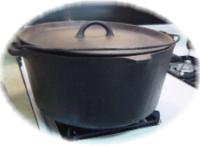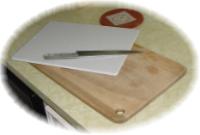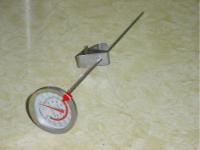 at least one with a thick bottom). Just about every Louisiana kitchen
has some cast iron cookware also, especially a big Dutch oven. To the
right is my pride and joy. A cast iron frying pan or two is also common.
I have one that I use only for corn bread. Also used widely is a good
stock pot and I prefer stainless steel; two or three gallon will do. Non-stick cookware is great but keep
the steel utensils out of them. A deep fryer is also good to have.
at least one with a thick bottom). Just about every Louisiana kitchen
has some cast iron cookware also, especially a big Dutch oven. To the
right is my pride and joy. A cast iron frying pan or two is also common.
I have one that I use only for corn bread. Also used widely is a good
stock pot and I prefer stainless steel; two or three gallon will do. Non-stick cookware is great but keep
the steel utensils out of them. A deep fryer is also good to have. Knives consist of at least one chefs knife, a boning knife and a paring knife. When purchasing knives spend a little more on quality forged and stainless steel types. Read More...When buying a set of knives that come with a block holder look at the description on the package carefully if the knives are hidden in the block. You want to be sure you're getting the knives with the cutting edges you need. Some sets come with all serrated edge knives. I'm not saying they're bad I just want you to be sure of what you're getting.
Along with your knives get a sharpening tool and learn how to use it! If I have to work with a dull knife I just as soon throw the stuff on the ground and run over it with the lawn mower. Fact is, when I go somewhere and I know I'm going to cook I bring my own knives! Read more on sharpeners..
Spoons are also essential. A few gravy spoons and a nice big ladle for those soups and gumbos is a must. When purchasing these spend a few more dollars on solid stainless steel types. Chrome plated spoons (usually the real shinny ones) are okay but sometimes the chrome plating will come off with heavy use and it will start rusting. There is also a roux spoon you may like.
Spatulas are a "can't do without" in my kitchen. Although good for flipping cackle-berries (eggs) I use them to make rouxs, sauté vegetables or just about anything that requires scraping the bottom of a pot or pan. Cooking Louisiana It's just logical, a flat bottom pot, a flat scraper! I use the plastic type because they can conform to uneven surfaces, and, they don't make that "fingernails on a chalkboard" noise! I use these for occasional stirring for a quick sauté. They will melt so don't leave it in the pot. Good wooden spatulas are available and I use those then I'm doing a lot of hard pot scrapping.
Forks and Tongs can't be forgotten. Having a few of different lengths of each won't hurt. Remember: Forks are for holding meat as you cut it. Tongs are for turning as it cooks. Not vice versa! If you pierce a piece of meat that is cooking with a fork here, you get on your knees in front of the house (so your other chef friends can see you)!
Cutting boards come in various materials. I like the wooden ones, but, it's your preference. Get something you can handle easily. Some people don't like wood because it holds things like salmonella (when cutting chicken). You can wash the board using soap and very hot water (the hot water should run over the surface for at least 30 seconds continuously).
 Note: The hot water principle holds true for
all cooking utensils. Shown here are wooden and polyethylene boards. Both work fine but polyethylene is USDA and NSF
(National Science Foundation) approved, and recommended by the
H.A.C.C.P. (Hazard Analysis and Critical Control Point) agencies. When
purchasing a board keep in mind what you'll be using it for. I have
pretty big boards so I have plenty of cutting and holding space; it's my
preference. You can also have a small board on hand to handle the light
stuff. Watch the weight too, some of these rascals are heavy.
Note: The hot water principle holds true for
all cooking utensils. Shown here are wooden and polyethylene boards. Both work fine but polyethylene is USDA and NSF
(National Science Foundation) approved, and recommended by the
H.A.C.C.P. (Hazard Analysis and Critical Control Point) agencies. When
purchasing a board keep in mind what you'll be using it for. I have
pretty big boards so I have plenty of cutting and holding space; it's my
preference. You can also have a small board on hand to handle the light
stuff. Watch the weight too, some of these rascals are heavy. Whisks are useful to blend liquids, and, a couple of sizes will do fine.
A clip-on cooking towel. A WHAT? Otherwise known a golfer's towel (small towel with a clip on it to hang on your belt loop). I just can't do without mine when the going gets tough!!! Don't use it to wipe fresh meat juices on, use paper towels.
Cooking Twine, used to tie stuffed & rolled meats and poultry legs, is handy. It's 100% cotton twine.
 Thermometers (meat and frying types) are required
hardware. Guessing is not acceptable! Cooking is ALL temperature
sensitive. My eyes can't tell the difference between 250° and 350° and I
doubt if yours can either!
Thermometers (meat and frying types) are required
hardware. Guessing is not acceptable! Cooking is ALL temperature
sensitive. My eyes can't tell the difference between 250° and 350° and I
doubt if yours can either! Here's a little more thermometer info.
Diffusers or Simmer Rings are used to disperse heat evenly on the bottom of a pot on the stove. This one is $4-5 on Amazon. There are other types but I find this type works just fine. I use them primarily if I have a pot of something on the stove and don't want it to burn while I'm doing something else, or just to simmer slowly.
Bakers stuff. I'm not much of a pastry guy (yet) but having a good mixer is required (I heard) and also a rolling pin and plenty of measuring equipment!
~~~~~~~~~~~~~~~~~~~~~~~~~~~~~~~~~~~
As your cooking grows so will your tools. Each of us finds the tools that work right for us and we use them. Whatever you buy spend a few more bucks and get something good, you won't regret it.
Back to Articles